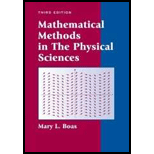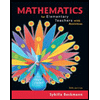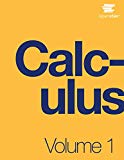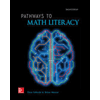
Mathematical Methods in the Physical Sciences
3rd Edition
ISBN: 9780471198260
Author: Mary L. Boas
Publisher: Wiley, John & Sons, Incorporated
expand_more
expand_more
format_list_bulleted
Textbook Question
Chapter 7.6, Problem 4P
For each of the periodic functions in Problems 5.1 to 5.11, use Dirichlet’s theorem to find the value to which the Fourier series converges at
Expert Solution & Answer
Want to see the full answer?
Check out a sample textbook solution
Chapter 7 Solutions
Mathematical Methods in the Physical Sciences
Ch. 7.2 - In Problems 1 to 6 find the amplitude, period,...Ch. 7.2 - In Problems 1 to 6 find the amplitude, period,...Ch. 7.2 - In Problems 1 to 6 find the amplitude, period,...Ch. 7.2 - In Problems 1 to 6 find the amplitude, period,...Ch. 7.2 - In Problems 1 to 6 find the amplitude, period,...Ch. 7.2 - In Problems 1 to 6 find the amplitude, period,...Ch. 7.2 - In Problems 7 to 10 you are given a complex...Ch. 7.2 - In Problems 7 to 10 you are given a complex...Ch. 7.2 - In Problems 7 to 10 you are given a complex...Ch. 7.2 - In Problems 7 to 10 you are given a complex...
Ch. 7.2 - The charge q on a capacitor in a simple a-c...Ch. 7.2 - RepeatProblem11:(a)ifq=Re4e30it;(b)ifq=Im4e30it.Ch. 7.2 - A simple pendulum consists of a point mass m...Ch. 7.2 - The displacements x of two simple pendulums (see...Ch. 7.2 - As in Problem 14, the displacements x of two...Ch. 7.2 - As in Problem 14, let the displacements be...Ch. 7.2 - Show that equation (2.10) for a wave can be...Ch. 7.2 - In Problems 18 to 20, find the amplitude, period,...Ch. 7.2 - In Problems 18 to 20, find the amplitude, period,...Ch. 7.2 - In Problems 18 to 20, find the amplitude, period,...Ch. 7.2 - Write the equation for a sinusoidal wave of...Ch. 7.2 - Do Problem 21 for a wave of amplitude 4, period 6,...Ch. 7.2 - Write an equation for a sinusoidal sound wave of...Ch. 7.2 - The velocity of sound in sea water is about...Ch. 7.2 - Write an equation for a sinusoidal radio wave of...Ch. 7.3 - For each of the following combinations of a...Ch. 7.3 - For each of the following combinations of a...Ch. 7.3 - For each of the following combinations of a...Ch. 7.3 - For each of the following combinations of a...Ch. 7.3 - Using the definition (end of Section 2) of a...Ch. 7.3 - In Problems 6 and 7, use a trigonometry formula to...Ch. 7.3 - In Problems 6 and 7, use a trigonometry formula to...Ch. 7.3 - A periodic modulated (AM) radio signal has the...Ch. 7.4 - Show that if f(x) has period p, the average value...Ch. 7.4 - (a) Prove that 0/2sin2xdx=0/2cos2xdx by making the...Ch. 7.4 - In Problems 3 to 12, find the average value of the...Ch. 7.4 - In Problems 3 to 12, find the average value of the...Ch. 7.4 - In Problems 3 to 12, find the average value of the...Ch. 7.4 - In Problems 3 to 12, find the average value of the...Ch. 7.4 - In Problems 3 to 12, find the average value of the...Ch. 7.4 - In Problems 3 to 12, find the average value of the...Ch. 7.4 - In Problems 3 to 12, find the average value of the...Ch. 7.4 - In Problems 3 to 12, find the average value of the...Ch. 7.4 - In Problems 3 to 12, find the average value of the...Ch. 7.4 - In Problems 3 to 12, find the average value of the...Ch. 7.4 - Using (4.3) and equations similar to (4.5) to...Ch. 7.4 - Use the results of Problem 13 to evaluate the...Ch. 7.4 - Use the results of Problem 13 to evaluate the...Ch. 7.4 - Use the results of Problem 13 to evaluate the...Ch. 7.5 - In each of the following problems you are given a...Ch. 7.5 - In each of the following problems you are given a...Ch. 7.5 - In each of the following problems you are given a...Ch. 7.5 - In each of the following problems you are given a...Ch. 7.5 - In each of the following problems you are given a...Ch. 7.5 - In each of the following problems you are given a...Ch. 7.5 - In each of the following problems you are given a...Ch. 7.5 - In each of the following problems you are given a...Ch. 7.5 - In each of the following problems you are given a...Ch. 7.5 - In each of the following problems you are given a...Ch. 7.5 - In each of the following problems you are given a...Ch. 7.5 - Show that in (5.2) the average values of...Ch. 7.5 - Write out the details of the derivation of...Ch. 7.6 - For each of the periodic functions in Problems 5.1...Ch. 7.6 - For each of the periodic functions in Problems 5.1...Ch. 7.6 - For each of the periodic functions in Problems 5.1...Ch. 7.6 - For each of the periodic functions in Problems 5.1...Ch. 7.6 - For each of the periodic functions in Problems 5.1...Ch. 7.6 - For each of the periodic functions in Problems 5.1...Ch. 7.6 - For each of the periodic functions in Problems 5.1...Ch. 7.6 - For each of the periodic functions in Problems 5.1...Ch. 7.6 - For each of the periodic functions in Problems 5.1...Ch. 7.6 - For each of the periodic functions in Problems 5.1...Ch. 7.6 - For each of the periodic functions in Problems 5.1...Ch. 7.6 - Use a computer to produce graphs like Fig. 6.2...Ch. 7.6 - Repeat the example using the same Fourier series...Ch. 7.6 - Use Problem 5.7 to show that oddn1/n2=2/8. Try...Ch. 7.6 - UseProblem5.11toshowthat1221+1421+1621+=12.Ch. 7.7 - Expand the same functions as in Problems 5.1 to...Ch. 7.7 - Expand the same functions as in Problems 5.1 to...Ch. 7.7 - Expand the same functions as in Problems 5.1 to...Ch. 7.7 - Expand the same functions as in Problems 5.1 to...Ch. 7.7 - Expand the same functions as in Problems 5.1 to...Ch. 7.7 - Expand the same functions as in Problems 5.1 to...Ch. 7.7 - Expand the same functions as in Problems 5.1 to...Ch. 7.7 - Expand the same functions as in Problems 5.1 to...Ch. 7.7 - Expand the same functions as in Problems 5.1 to...Ch. 7.7 - Expand the same functions as in Problems 5.1 to...Ch. 7.7 - Expand the same functions as in Problems 5.1 to...Ch. 7.7 - Show that if a real f(x) is expanded in a complex...Ch. 7.7 - If f(x)=12a0+1ancosnx+1bnsinnx=cneinx, use Eulers...Ch. 7.8 - In Problems 5.1 to 5.9, define each function by...Ch. 7.8 - In Problems 5.1 to 5.9, define each function by...Ch. 7.8 - In Problems 5.1 to 5.9, define each function by...Ch. 7.8 - In Problems 5.1 to 5.9, define each function by...Ch. 7.8 - In Problems 5.1 to 5.9, define each function by...Ch. 7.8 - In Problems 5.1 to 5.9, define each function by...Ch. 7.8 - In Problems 5.1 to 5.9, define each function by...Ch. 7.8 - In Problems 5.1 to 5.9, define each function by...Ch. 7.8 - In Problems 5.1 to 5.9, define each function by...Ch. 7.8 - (a) Sketch several periods of the function f(x) of...Ch. 7.8 - In Problems 11 to 14, parts (a) and (b), you are...Ch. 7.8 - In Problems 11 to 14, parts (a) and (b), you are...Ch. 7.8 - In Problems 11 to 14, parts (a) and (b), you are...Ch. 7.8 - In Problems 11 to 14, parts (a) and (b), you are...Ch. 7.8 - Sketch (or computer plot) each of the following...Ch. 7.8 - Each of the following functions is given over one...Ch. 7.8 - Each of the following functions is given over one...Ch. 7.8 - Each of the following functions is given over one...Ch. 7.8 - Each of the following functions is given over one...Ch. 7.8 - Each of the following functions is given over one...Ch. 7.8 - Write out the details of the derivation of the...Ch. 7.9 - The functions in Problems 1 to 3 are neither even...Ch. 7.9 - The functions in Problems 1 to 3 are neither even...Ch. 7.9 - The functions in Problems 1 to 3 are neither even...Ch. 7.9 - The functions in Problems 1 to 3 are neither even...Ch. 7.9 - Each of the functions in Problems 5 to 12 is given...Ch. 7.9 - Each of the functions in Problems 5 to 12 is given...Ch. 7.9 - Each of the functions in Problems 5 to 12 is given...Ch. 7.9 - Each of the functions in Problems 5 to 12 is given...Ch. 7.9 - Each of the functions in Problems 5 to 12 is given...Ch. 7.9 - Each of the functions in Problems 5 to 12 is given...Ch. 7.9 - Each of the functions in Problems 5 to 12 is given...Ch. 7.9 - Each of the functions in Problems 5 to 12 is given...Ch. 7.9 - Give algebraic proofs of (9.3). Hint: Write...Ch. 7.9 - Give algebraic proofs that for even and odd...Ch. 7.9 - Given f(x)=x for 0x1, sketch the even function fc...Ch. 7.9 - Let f(x)=sin2x,0x. Sketch (or computer plot) the...Ch. 7.9 - In Problems 17 to 22 you are given f(x) on an...Ch. 7.9 - In Problems 17 to 22 you are given f(x) on an...Ch. 7.9 - In Problems 17 to 22 you are given f(x) on an...Ch. 7.9 - In Problems 17 to 22 you are given f(x) on an...Ch. 7.9 - In Problems 17 to 22 you are given f(x) on an...Ch. 7.9 - In Problems 17 to 22 you are given f(x) on an...Ch. 7.9 - If a violin string is plucked (pulled aside and...Ch. 7.9 - If, in Problem 23, the string is stopped at the...Ch. 7.9 - Suppose that f(x) and its derivative f(x) are both...Ch. 7.9 - In Problems 26 and 27, find the indicated Fourier...Ch. 7.9 - In Problems 26 and 27, find the indicated Fourier...Ch. 7.10 - In Problems 1 to 3, the graphs sketched represent...Ch. 7.10 - In Problems 1 to 3, the graphs sketched represent...Ch. 7.10 - In Problems 1 to 3, the graphs sketched represent...Ch. 7.10 - In Problems 4 to 10, the sketches show several...Ch. 7.10 - In Problems 4 to 10, the sketches show several...Ch. 7.10 - In Problems 4 to 10, the sketches show several...Ch. 7.10 - In Problems 4 to 10, the sketches show several...Ch. 7.10 - In Problems 4 to 10, the sketches show several...Ch. 7.10 - In Problems 4 to 10, the sketches show several...Ch. 7.10 - In Problems 4 to 10, the sketches show several...Ch. 7.11 - Prove (11.4) for a function of period 2l expanded...Ch. 7.11 - Prove that if f(x)=i=cneinx, then the average...Ch. 7.11 - If f(x) is complex, we usually want the average of...Ch. 7.11 - When a current I flows through a resistance R, the...Ch. 7.11 - Use Parsevals theorem and the results of the...Ch. 7.11 - Use Parsevals theorem and the results of the...Ch. 7.11 - Use Parsevals theorem and the results of the...Ch. 7.11 - Use Parsevals theorem and the results of the...Ch. 7.11 - Use Parsevals theorem and the results of the...Ch. 7.11 - A general form of Parsevals theorem says that if...Ch. 7.11 - Let f(x) on (0,2l) satisfy f(2lx)=f(x), that is,...Ch. 7.12 - Following a method similar to that used in...Ch. 7.12 - Do Example 1 above by using a cosine transform...Ch. 7.12 - In Problems 3 to 12, find the exponential Fourier...Ch. 7.12 - In Problems 3 to 12, find the exponential Fourier...Ch. 7.12 - In Problems 3 to 12, find the exponential Fourier...Ch. 7.12 - In Problems 3 to 12, find the exponential Fourier...Ch. 7.12 - In Problems 3 to 12, find the exponential Fourier...Ch. 7.12 - In Problems 3 to 12, find the exponential Fourier...Ch. 7.12 - In Problems 3 to 12, find the exponential Fourier...Ch. 7.12 - In Problems 3 to 12, find the exponential Fourier...Ch. 7.12 - In Problems 3 to 12, find the exponential Fourier...Ch. 7.12 - In Problems 3 to 12, find the exponential Fourier...Ch. 7.12 - In Problems 13 to 16, find the Fourier cosine...Ch. 7.12 - In Problems 13 to 16, find the Fourier cosine...Ch. 7.12 - In Problems 13 to 16, find the Fourier cosine...Ch. 7.12 - In Problems 13 to 16, find the Fourier cosine...Ch. 7.12 - In Problems 17 to 20, find the Fourier sine...Ch. 7.12 - In Problems 17 to 20, find the Fourier sine...Ch. 7.12 - In Problems 17 to 20, find the Fourier sine...Ch. 7.12 - In Problems 17 to 20, find the Fourier sine...Ch. 7.12 - Find the Fourier transform of f(x)=ex2/22. Hint:...Ch. 7.12 - The function j1()=(cossin)/ is of interest in...Ch. 7.12 - Using Problem 17, show that...Ch. 7.12 - (a) Find the exponential Fourier transform of...Ch. 7.12 - (a) Represent as an exponential Fourier transform...Ch. 7.12 - Using Problem 15, show that 01cos2d=2.Ch. 7.12 - Represent each of the following functions (a) by a...Ch. 7.12 - Represent each of the following functions (a) by a...Ch. 7.12 - Represent each of the following functions (a) by a...Ch. 7.12 - Represent each of the following functions (a) by a...Ch. 7.12 - Verify Parsevals theorem (12.24) for the special...Ch. 7.12 - Verify Parsevals theorem (12.24) for the special...Ch. 7.12 - Verify Parsevals theorem (12.24) for the special...Ch. 7.12 - Show that if (12.2) is written with the factor 1/2...Ch. 7.12 - Starting with the symmetrized integrals as in...Ch. 7.12 - Normalize f(x) in Problem 21; that is find the...Ch. 7.13 - The displacement (from equilibrium) of a particle...Ch. 7.13 - The symbol [x] means the greatest integer less...Ch. 7.13 - We have said that Fourier series can represent...Ch. 7.13 - The diagram shows a relaxation oscillator. The...Ch. 7.13 - Consider one arch of f(x)=sinx. Show that the...Ch. 7.13 - Let f(t)=eit on (,). Expand f(t) in a complex...Ch. 7.13 - Given f(x)=x on (,), expand f(x) in an appropriate...Ch. 7.13 - From facts you know, find in your head the average...Ch. 7.13 - Given f(x)= x,0x1, 2,1x2. (a) Sketch at least...Ch. 7.13 - (a) Sketch at least three periods of the graph of...Ch. 7.13 - Find the three Fourier series in Problems 9 and...Ch. 7.13 - What would be the apparent frequency of a sound...Ch. 7.13 - (a) Given f(x)=(x)/2 on (0,), find the sine series...Ch. 7.13 - (a) Find the Fourier series of period 2 for...Ch. 7.13 - Given f(x)=1,2x0,1,0x2, find the exponential...Ch. 7.13 - Given f(x)=x,0x1,2x,1x2,0,x2, find the cosine...Ch. 7.13 - Show that the Fourier sine transform of x1/2 is...Ch. 7.13 - Let f(x) and g() be a pair of Fourier transforms....Ch. 7.13 - Find the form of Parsevals theorem ( 12.24) for...Ch. 7.13 - Find the exponential Fourier transform of...Ch. 7.13 - Define a function h(x)=k=f(x+2k), assuming that...Ch. 7.13 - Use Poissons formula (Problem 21b) and Problem 20...Ch. 7.13 - Use Parsevals theorem and Problem 12.11 to...
Additional Math Textbook Solutions
Find more solutions based on key concepts
For the following exercises, use shells to find the volume generated by rotating the regions between the given ...
Calculus Volume 2
The table by using the given graph of h.
Calculus for Business, Economics, Life Sciences, and Social Sciences (14th Edition)
Two twists. Take a strip of paper, put two half twists in it, and glue the ends together. Cut it lengthwise alo...
The Heart of Mathematics: An Invitation to Effective Thinking
Sharpening Your Skills In Exercise 110, determine which sentences are statements. The Walking Dead is a popular...
Mathematics All Around (6th Edition)
Percentiles. The pth percentile of a sorted data set is a number xp such that p of the data fall at or below xp...
Excursions in Modern Mathematics (9th Edition)
Family Library The Venn diagram in Fig. 10 classifies the 100 books in a familys library as hardback (H), ficti...
Finite Mathematics & Its Applications (12th Edition)
Knowledge Booster
Learn more about
Need a deep-dive on the concept behind this application? Look no further. Learn more about this topic, subject and related others by exploring similar questions and additional content below.Recommended textbooks for you
 Discrete Mathematics and Its Applications ( 8th I...MathISBN:9781259676512Author:Kenneth H RosenPublisher:McGraw-Hill Education
Discrete Mathematics and Its Applications ( 8th I...MathISBN:9781259676512Author:Kenneth H RosenPublisher:McGraw-Hill Education Mathematics for Elementary Teachers with Activiti...MathISBN:9780134392790Author:Beckmann, SybillaPublisher:PEARSON
Mathematics for Elementary Teachers with Activiti...MathISBN:9780134392790Author:Beckmann, SybillaPublisher:PEARSON
 Thinking Mathematically (7th Edition)MathISBN:9780134683713Author:Robert F. BlitzerPublisher:PEARSON
Thinking Mathematically (7th Edition)MathISBN:9780134683713Author:Robert F. BlitzerPublisher:PEARSON Discrete Mathematics With ApplicationsMathISBN:9781337694193Author:EPP, Susanna S.Publisher:Cengage Learning,
Discrete Mathematics With ApplicationsMathISBN:9781337694193Author:EPP, Susanna S.Publisher:Cengage Learning, Pathways To Math Literacy (looseleaf)MathISBN:9781259985607Author:David Sobecki Professor, Brian A. MercerPublisher:McGraw-Hill Education
Pathways To Math Literacy (looseleaf)MathISBN:9781259985607Author:David Sobecki Professor, Brian A. MercerPublisher:McGraw-Hill Education

Discrete Mathematics and Its Applications ( 8th I...
Math
ISBN:9781259676512
Author:Kenneth H Rosen
Publisher:McGraw-Hill Education

Mathematics for Elementary Teachers with Activiti...
Math
ISBN:9780134392790
Author:Beckmann, Sybilla
Publisher:PEARSON


Thinking Mathematically (7th Edition)
Math
ISBN:9780134683713
Author:Robert F. Blitzer
Publisher:PEARSON

Discrete Mathematics With Applications
Math
ISBN:9781337694193
Author:EPP, Susanna S.
Publisher:Cengage Learning,

Pathways To Math Literacy (looseleaf)
Math
ISBN:9781259985607
Author:David Sobecki Professor, Brian A. Mercer
Publisher:McGraw-Hill Education
But what is the Fourier Transform? A visual introduction.; Author: 3Blue1Brown;https://www.youtube.com/watch?v=spUNpyF58BY;License: Standard YouTube License, CC-BY